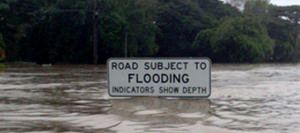DisastersWho is the culprit in the Queensland floods: man or nature?
Climate change may contribute to the intensification of natural disasters, but the major drivers of the rapidly rising costs of natural disasters — in Australia and around the world — are societal changes such as increases in population, wealth, and inflation, not climate change; the only way to reduce the scale of future disasters in Australia are risk-informed land planning policies with risks appropriately priced by an active insurance market; in simple terms, for flood and bushfire, this means an end to unmanaged development of flood plains or within bushlands

Sometimes no explanation is necessary // Source: asg.com.au
This month’s flooding in Queensland is yet another reminder of the destructive power of nature. Globally the costs of natural disasters are increasing rapidly, fuelled by societal changes such as increases in population, wealth, and inflation, not climate change. Across different natural hazards and jurisdictions, some twenty-two separate peer-reviewed studies of weather-related natural disaster events now attest to this fact say Macquarie University’s John McAneney and Kevin Roche.
McAneney and Roche work for Risk Frontiers, an independent research center at Macquarie University which is devoted to the understanding and pricing of catastrophe risks for the insurance and emergency management sectors. John McAneney is the director of the Center. Kevin Roche is a Ph.D. candidate. Recently Roche’s paper on Policy Options for Managing Flood Insurance was published in the journal Environmental Hazards.
Roche and McAneney say the problem is that we now have more people living in vulnerable areas, with more to lose. In Australia, migration of people toward the coast has meant that South Eastern Queensland and Northern NSW are amongst the most rapidly growing areas in the country.
The footprint of the current Brisbane flooding is very similar to the 1974 flood, but the value of assets and the population at risk has increased enormously in the intervening years.
The researchers say there are those who, as was the case for the losses incurred in the 2009 Black Saturday fires, will lay the blame on global climate change. Comments such as those made by the leader of Australia’s Greens, Senator Bob Brown, blaming the coal industry for the floods are a distraction and do not acknowledge the accumulated and rapidly growing risk that exists in the absence of any change in climate, they say.
To what extent climate change is implicated in terms of the rainfall, is a perfectly legitimate question, though not one easily answered. Seeking to blame the human tragedy in its entirety on climate change, however, is simply looking in the wrong direction, the researchers say.
They note that the city of Brisbane, like many other towns in Queensland, is built on a floodplain. Compared with the current disaster, there have been even bigger floods in the past: in 1841 and 1893 when flood waters topped 8.35 meters, some 3.9 meters above the latest peak. After the 1974 floods, the senior engineer with the Hydrometeorology Branch of the Bureau of Meteorology, G. Heatherwick, warned that heavier rainfalls were possible over the Bremer river catchment with higher flooding in Ipswich, independent of the flood mitigation effects of the Wivenhoe Dam.
This is not to deny that climate change is a real concern say the researchers — few continue to believe that only positive outcomes will arise from the continued heating of our planet. The latest research, however, just published in the international journal Environmental Research Letters by Risk Frontiers Ryan Crompton and McAneney together with the University of Colorado Boulder’s Roger Pielke Jr., suggests that it may be centuries until we can be confident that climate change is influencing disaster losses.
An article, published 4 January about their research, also appeared in the New York Times.
Roche and McAneney say if we truly wish to reduce the scale of future disasters in Australia, there is a need for risk-informed land planning policies with risks appropriately priced by an active insurance market. In simple terms, for flood and bushfire, this means an end to unmanaged development of flood plains or within bushlands.
In the Black Saturday fires, studies by Risk Frontiers showed that 25 percent of the home destruction in the most affected towns of Marysville and Kinglake took place physically within bushlands; 60 percent occurred within 10 m of bushland boundaries. At these distances, chances of home survival are low and not surprisingly few resisted the flames.
Extreme weather is not new to Australia with some 95 percent of all property losses in natural disasters since 1900 attributable to flood, hail, bushfire or tropical cyclones. Excluding the case of improved construction standards for residential homes in cyclone-prone areas of the country, however, successive Australian governments, at all levels, have failed to address short comings of land policy solutions to mitigate against the potential impacts of natural disasters, Roche and McAneney say.
In the emotional days after the Black Saturday fires of 2009, they note that the then Australian prime minster, Kevin Rudd, stated that we would rebuild impacted communities “brick by brick.” There was no immediate consideration about reducing risks. Roche and McAneney say they hope the official reaction to these floods is more measured.
